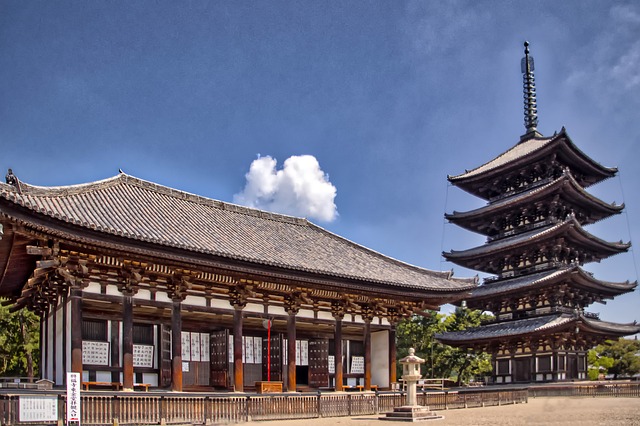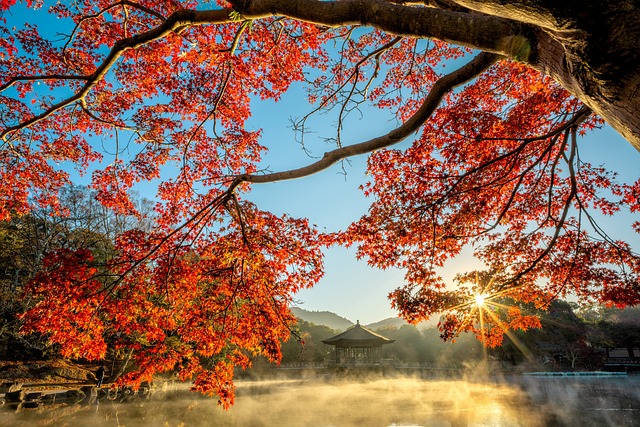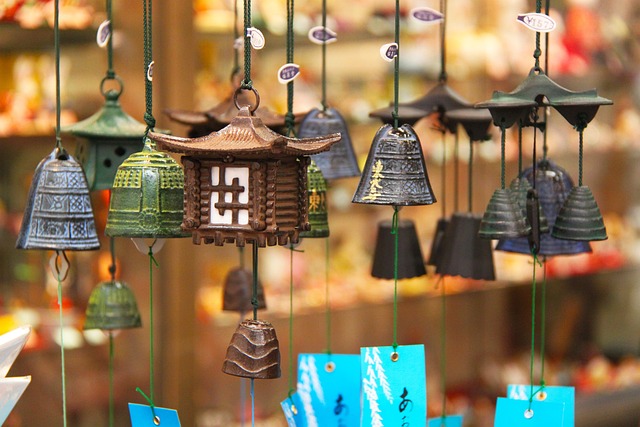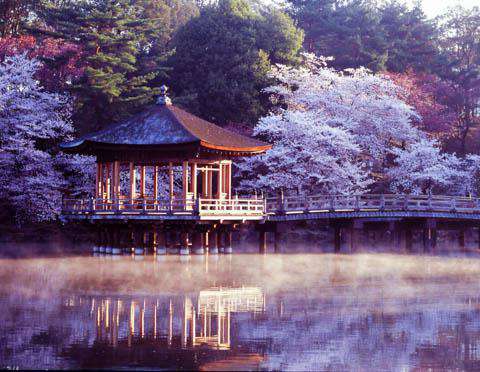It's no surprise that Nara sees many visitors since it offers museums and attractions, nightlife, hiking, and family-friendly activities.
In Nara, Nara Park is the place where most of the city's sights are concentrated. Temples, shrines, and semi-wild deer span across a wide, pleasant space of greenery. Visitors can enjoy the wildlife and even feed the deer in Nara. The Daibutsu-den, which houses the second largest Buddha statue in Japan, is said to be the largest wooden building in the world and is a UNESCO World Heritage site. There is a giant front gate guarded by two fierce protectors, and there are many other giant statues and relics to be found on site.
Kofuku-ji is a temple with a three-story and a five-story pagoda that can be viewed beautifully from Sarusawa Pond. Other temples and shrines of the park include Himuro Shrine surrounded by cherry trees, Ukimido built upon Sagiike Pond, Shin-Yakushi-ji with fierce warrior statues and a Buddha of healing, and Kasuga Taisha with a giant rack of sake barrels near the front gate and the fountain-statue of a giant buck.
Nara National Museum has one of the world's best collections of Buddhist art and changing exhibitions, while some of the park's natural beauties can be viewed at the Kasuga-yama Hill Primeval Forest, Isui-en Garden, and the Yoshikien Garden.
With so much history and so many World Heritage Sites (both those mentioned above as well as others in the surrounding areas), sight-seeing can occupy most of a visit. Some worthwhile sights not yet mentioned include temple complexes like Yakushi-ji and Gango-ji as well as the Heijokyu Palace Site.
The Mount Wakakusa Fire Festival is a celebration usually held the night before the 2nd Monday in January. Great fireworks and the dry grass on the slopes of this mountain are set on fire by two temples, and can make for a spectacular show. There is also an annual light festival in August called Nara Toka-e, where 10,000 candles illuminate the area around Nara Park and major temples. The most traditional, however, is Shuni-e (Omozu-tori) which has been celebrated annual since 752 AD. During the first two weeks of March, priests perform a Buddhist memorial service every evening, running around the Nigatsu-do carrying large flaming torches
Museums and Attractions:
 Museums and historic landmarks are a big part of what makes Nara so popular. The city is filled with history. There are many ancient temples such as Tōdai-ji Temple, Kofuku-ji Temple, Yakushi-ji Temple, and Tōshōdai-ji Temple. You can also visit the Nara National Museum as well as the many parks and gardens.
Museums and historic landmarks are a big part of what makes Nara so popular. The city is filled with history. There are many ancient temples such as Tōdai-ji Temple, Kofuku-ji Temple, Yakushi-ji Temple, and Tōshōdai-ji Temple. You can also visit the Nara National Museum as well as the many parks and gardens.
Hiking:
 Many hikers rave about the trails surrounding Nara. The city is all about its surrounding nature. There are historic pilgrim routes that pass through the hills and mountains, taking you by sacred sights and ancient forests. In the area you'll find some of Japan's most ancient byways.
Many hikers rave about the trails surrounding Nara. The city is all about its surrounding nature. There are historic pilgrim routes that pass through the hills and mountains, taking you by sacred sights and ancient forests. In the area you'll find some of Japan's most ancient byways.
Shopping:
 Visiting this shopping destination is an experience you can't afford to miss. Sanjo-dori is the main street through town. This is where you'll find many souvenir shops that sell local items and traditional food. Mochiido Center Town is the oldest shopping arcade in town and it is filled with history.
Visiting this shopping destination is an experience you can't afford to miss. Sanjo-dori is the main street through town. This is where you'll find many souvenir shops that sell local items and traditional food. Mochiido Center Town is the oldest shopping arcade in town and it is filled with history.
Local tours that last a few hours can be a great way to explore Nara. Prices vary by the type of activity or tour, the dates, and the size of the group. Here are a few of the highest rated tours by previous visitors:
- Perfect Nara Park Half-Day Bus Tour with English Speaking Guide for $69 details
- Private Nara Tour and Sake Tasting (Departing from Kyoto/Nara) for $173 details
- Slow Cycling Tour at Uji's Matcha Green Tea Fields and Heritage for $137 details
 Ukimido Pavilion, Nara, Japan (©NARA TOURISM FEDERATION/©JNTO)
Ukimido Pavilion, Nara, Japan (©NARA TOURISM FEDERATION/©JNTO)

 Museums and historic landmarks are a big part of what makes Nara so popular. The city is filled with history. There are many ancient temples such as Tōdai-ji Temple, Kofuku-ji Temple, Yakushi-ji Temple, and Tōshōdai-ji Temple. You can also visit the Nara National Museum as well as the many parks and gardens.
Museums and historic landmarks are a big part of what makes Nara so popular. The city is filled with history. There are many ancient temples such as Tōdai-ji Temple, Kofuku-ji Temple, Yakushi-ji Temple, and Tōshōdai-ji Temple. You can also visit the Nara National Museum as well as the many parks and gardens. Many hikers rave about the trails surrounding Nara. The city is all about its surrounding nature. There are historic pilgrim routes that pass through the hills and mountains, taking you by sacred sights and ancient forests. In the area you'll find some of Japan's most ancient byways.
Many hikers rave about the trails surrounding Nara. The city is all about its surrounding nature. There are historic pilgrim routes that pass through the hills and mountains, taking you by sacred sights and ancient forests. In the area you'll find some of Japan's most ancient byways. Visiting this shopping destination is an experience you can't afford to miss. Sanjo-dori is the main street through town. This is where you'll find many souvenir shops that sell local items and traditional food. Mochiido Center Town is the oldest shopping arcade in town and it is filled with history.
Visiting this shopping destination is an experience you can't afford to miss. Sanjo-dori is the main street through town. This is where you'll find many souvenir shops that sell local items and traditional food. Mochiido Center Town is the oldest shopping arcade in town and it is filled with history.
 Budget Your Trip is all about finding out how much everything costs so that you can travel cheaper and longer. Created by avid travelers Laurie and Bryan, our goal is to help you plan your next trip on the right budget. With average daily travel costs that are calculated from the budgets of real travelers, plus an analysis of hotel and tour prices, you can find out how much money you need to plan your next adventure. We also have plenty of travel advice, accommodation reviews, and activity suggestions.
Budget Your Trip is all about finding out how much everything costs so that you can travel cheaper and longer. Created by avid travelers Laurie and Bryan, our goal is to help you plan your next trip on the right budget. With average daily travel costs that are calculated from the budgets of real travelers, plus an analysis of hotel and tour prices, you can find out how much money you need to plan your next adventure. We also have plenty of travel advice, accommodation reviews, and activity suggestions.